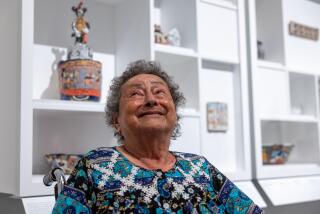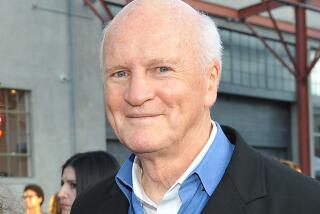Spain’s Big Win: The Baron’s Art : Art: The nation will pay $350 million for 775 works from Baron Thyssen-Bornemisza’s 1,000-piece collection, which is valued at $2 billion. Malibu’s Getty Museum and heads of state sought the unique private holdings.
- Share via
An announcement on Friday that the government of Spain had agreed to purchase about 775 artworks from Baron Hans Heinrich Thyssen-Bornemisza for $350 million ended seven years of speculation about the fate of the Swiss industrialist’s celebrated collection.
Thyssen had been courted by the J. Paul Getty Museum in Malibu and heads of state from Britain, Germany and France--all of whom were eager to accommodate the $2-billion, 1,000-work private collection that is second only to that of Queen Elizabeth II’s. So numerous were the baron’s suitors that he once joked, “I keep a list of countries from Albania to Zululand that want my collection.”
But when the agreement finally became public the only surprises were the timing and the bargain purchase price. Thyssen’s fifth wife, Carmen (Tita) Cervera of Spain, is credited with persuading the baron to move his collection from its longtime home in Lugano, Switzerland, to the capital of her native land. Amid a highly publicized celebration last October, a museum for the Thyssen collection opened in Madrid, about 100 yards from the Prado. The deal provided the Spanish government with a nine-year lease on the collection, at about $6 million a year, and an option to buy the artworks.
Museum directors and other art world insiders say the purchase--to be completed over a five-year period--was expected. “Thyssen looked at a lot of possibilities seriously in the late ‘80s, but it was clear for quite a while that Spain had the inside track,” Getty Museum Director John Walsh said.
Walsh acknowledged that the Getty had pursued the collection but declined to discuss specific plans. “Thyssen is an old friend. We’ve had communication with him going back a long time about the future of the collection, but we have known for quite a while that it would go to Spain,” he said.
Expected or not, a $350-million purchase of a private collection by a nation is unprecedented. “I can’t think of another case like that,” said Earl A. (Rusty) Powell III, director of the National Gallery of Art in Washington and former director of the Los Angeles County Museum of Art. Andrew W. Mellon founded the National Gallery with a gift of 126 paintings and 26 sculptures, and important caches of artworks subsequently acquired by the gallery--including the Samuel H. Kress, Chester Dale and Widener collections--were all donated.
*
Thyssen, a 72-year-old billionaire who expanded an inherited fortune in a business empire including international interests in glass, plastics, automobile parts and container leasing, might have been expected to donate his collection rather than sell it. But Walsh offered an explanation: “He had to settle (his financial affairs) with his children, and the largest part of his assets were tied up with works of art. He is a good businessman who knows his collection has a large value and that it is not legally tied to Lugano. . . . He explored many possibilities to come to an arrangement with his heirs and to put the collection in a place that pleased him.”
Furthermore, Walsh said, $350 million is only a fraction of the collection’s value.
The collection includes works from the 13th through the 20th centuries by major figures ranging from Old Masters Hans Memling and Vittore Carpaccio to contemporary artists Roy Lichtenstein and David Hockney. The “great rarities” are Italian and German Renaissance pictures, Walsh said. While Spain is already fabulously rich in its native art, its collection “is a little lopsided,” he said. Thyssen’s 19th- and 20th-Century works from outside Spain, including paintings by American artists John Singer Sargent and Winslow Homer, will fill some notable gaps.
News of Thyssen’s planned alliance with Spain shocked the art world several years ago, but it was in keeping with his quintessentially international persona. Born in the Netherlands to a German father and a Hungarian mother, he is a citizen of Switzerland, but--for tax purposes--an official resident of Monte Carlo. His five wives have come from Germany, Britain, Scotland, Brazil and Spain.
Thyssen acquired the core of his art collection from his father, also named Heinrich, who left his native Germany in 1905, settled in Hungary and married the daughter of the king’s chamberlain, who passed on his barony to his son-in-law. To accommodate the title, young Heinrich Thyssen added his father-in-law’s last name, becoming Baron Thyssen-Bornemisza. In 1924, after moving to Rotterdam, Heinrich inherited a fortune and became a banker and shipping magnate, investing much of his profit in Old Master artworks.
He moved his family and his art collection to Switzerland before the outbreak of World War II. A few years later, he bought an 18th-Century villa near Lugano, named it Villa Favorita, and turned it into a private museum. Heinrich wanted the collection to remain intact, and his namesake, Baron Thyssen-Bornemisza concurred. But after their father’s death in 1947, the baron’s three siblings successfully sued for their share of the collection and it was divided among them. The baron spent about 15 years buying back the paintings from his siblings, while building his own business empire.
His father had viewed artwork made after the 18th Century as “rubbish,” according to the baron, and he initially followed his father’s example. But in the 1960s he began buying German Expressionist works and soon expanded his range dramatically.
Now known as a mega-collector, the baron sent large exhibitions of parts of his collection on international tours. A show of Thyssen’s Old Masters visited the Los Angeles County Museum of Art in 1980, and an exhibition of American artworks stopped at the San Diego Museum of Art in 1985. He also opened Villa Favorita to the public, leading to assumptions that Lugano would be the collection’s permanent home. But Thyssen became disenchanted with Switzerland in 1986, when he asked the city of Lugano and the canton of Ticino to help with a planned $20-million expansion of the villa, which had become a major tourist attraction and source of community revenue. He was insulted by an initial offer of $2.8 million and let it be known that he might take his collection elsewhere.
The Swiss eventually offered to pay for the entire new wing, but it was too late. Thyssen, who in 1985 had married his fifth wife, a former Miss Spain 23 years his junior, had been persuaded to move his collection to Spain. He signed a lease agreement in 1988, including a requirement that Villahermosa Palace be refurbished to his specifications, at a cost of about $45 million. There was a public uproar when it became known that the deal involved a lease and not a donation, but in 1990 the Spanish Parliament approved the agreement. Six thousand people visited the museum on opening day; a total 750,000 visitors have flocked to it during the last eight months.
More to Read
The biggest entertainment stories
Get our big stories about Hollywood, film, television, music, arts, culture and more right in your inbox as soon as they publish.
You may occasionally receive promotional content from the Los Angeles Times.










